Abstract
Annual estimates of defoliation are important tools for managing forest insect defoliators such as the hemlock looper, which feeds on conifer needles of all age classes. We tested the accuracy of defoliation classes obtained from aerial surveys by comparing them with ground-based estimates during a recent outbreak of this insect. We used an approach derived from the Fettes method to estimate defoliation on the current-year shoots as well as on the shoots of the four previous years. Defoliation on the current-year shoots provided accurate estimates of the overall defoliation and the strength of the relationship gradually decreasing for one-year-old to four-year-old foliage. The aerial survey provided accurate estimates of light and moderate defoliation during the first year of the outbreak, but accuracy was lower for both ends of the defoliation gradient and was much less reliable after the second year of the outbreak. All levels of defoliation were then observed in stands where defoliation had not been detected by an aerial survey. Cumulative defoliation on all age classes of foliage brings a new challenge to crews assigned to aerial survey programs. Ground-level defoliation estimates on the current-year shoots can help appraise the risk of tree mortality in the following year.
1. Introduction
The hemlock looper, Lambdina fiscellaria (Guenée) (Lepidoptera: Geometridae), is the second most important insect defoliator of balsam fir (Abies balsamea (L.) Mill.) in eastern North America after the spruce budworm, Choristoneura fumiferana (Clemens) (Lepidoptera: Tortricidae) [1]. Despite its common name, only one major outbreak of hemlock looper has been reported in hemlock stands in Maine, USA, where over 90,000 ha were defoliated in the early 1990s [2]. In fact, the most destructive outbreaks of the hemlock looper have been recorded in balsam fir forests of eastern Quebec and Newfoundland in Canada, near large bodies of water, suggesting that they may be associated with a mild and humid maritime climate [3,4,5]. The outbreak studied here was located in the Parc national de la Jacques-Cartier and the Forêt Montmorency, far away from the usual outbreak areas. It was the first-ever reported outbreak of the hemlock looper in this much colder but very humid continental region of Canada, suggesting that it may be linked to climate warming [6].
The hemlock looper is univoltine and overwinters in the egg stage. Eggs are laid on the trunk or branches of living trees, snags, and in sphagnum moss cover when populations are extremely high [7,8,9]. The eggs hatch late in spring, and the young larvae initially feed on the current year’s needles. Later in their development, the larvae migrate to feed on the previous year’s needles. Thus, the larvae chew the needles of all age classes without completely consuming them [5,10]. During an outbreak, this wasteful feeding behavior causes damage to almost all of the needles, which will eventually dry up and fall off in the late summer; thus, the hemlock looper can kill trees after just 1 or 2 years of heavy defoliation [6,10,11]. This is much faster than for the spruce budworm, which generally feeds only on the current year’s shoots, except when populations are extremely high where back-feeding of larvae on the old foliage can occur. Therefore, the spruce budworm kills balsam firs after 4 to 5 years of heavy defoliation [12,13]. Late in summer, the hemlock looper larvae seek out pupation sites, most often in trunk crevices or under strips of bark on host trees [8,14,15]. Adults emerge after about 20 days of pupation, where they mate and lay eggs singly or in groups of two or three [9].
Annual estimates of defoliation are essential tools for managing forest insect defoliators. They are usually obtained by aerial surveys of defoliation to assist forest managers in their operational decisions [16], but they are also useful for research purposes [17,18,19]. In coniferous forests, aerial assessment of defoliation is usually based on the characteristic reddish-brown coloration of tree foliage resulting from insect feeding [10]. It is important to validate how these large-scale aerial estimates of defoliation fit with the stand-level estimates. For the spruce budworm, aerial sketch maps of defoliation were deemed appropriate for management purposes, with misclassifications resulting primarily from difficulties in detecting and correctly assessing patches of light defoliation, which are not retained in spray programs [16]. To our knowledge, the only study comparing aerial surveys of hemlock looper defoliation to ground surveys over two successive years was conducted on seven balsam fir plots in Newfoundland [10]. Helicopters were used, and no data were collected for lightly (˂35%) defoliated stands. In Quebec, aerial surveys of defoliation were carried out with aircraft, but no study was found to attest to the accuracy of the different severity classes of hemlock looper defoliation.
Because the hemlock looper feeds on all age classes of foliage, estimating annual defoliation resulting from its feeding might be more difficult than for the spruce budworm. The amount of foliage that can redden because of the looper defoliation may rapidly decrease during an outbreak of this insect while foliage on which the spruce budworm larvae feed (mainly the current-year shoots) is renewed each year. For instance, a 50% defoliation by the hemlock looper after the first year of an outbreak is estimated on the full foliage of the trees, while the same level of defoliation on the same trees after the second year of an outbreak is estimated on much less foliage. This could influence the color signal intensity used to assess defoliation during aerial surveys. Thus, at the ground level, the most accurate estimate of annual hemlock looper defoliation may be obtained from the current-year shoots, but the extent to which it relates to the overall defoliation is unknown. In this paper, our objectives were to (1) verify if defoliation on the current-year shoots is a good proxy of the overall defoliation at ground level and (2) verify the accuracy of aerial surveys carried out for assessing the hemlock looper annual defoliation over the first 2 years of an outbreak.
2. Materials and Methods
2.1. Study Area
This study was carried out in the Parc national de la Jacques-Cartier (47°06′ N, 71°20′ W) and in the Forêt Montmorency (47°19′ N, 71°09′ W), both located approximately 70 km north of Quebec City (Figure 1). Both areas belong to the balsam fir-white birch bioclimatic domain within the continuous boreal forest sub-zone [20]. Balsam fir stands largely dominate the landscape; however, the black spruce (Picea mariana (Mill.) B.S.P.), white spruce (Picea glauca (Moench) Voss.), white birch (Betula papyrifera Marsh.), American mountain-ash (Sorbus americana Marsh.), and trembling aspen (Populus tremuloides Michx.) are the most common companion species in these stands.
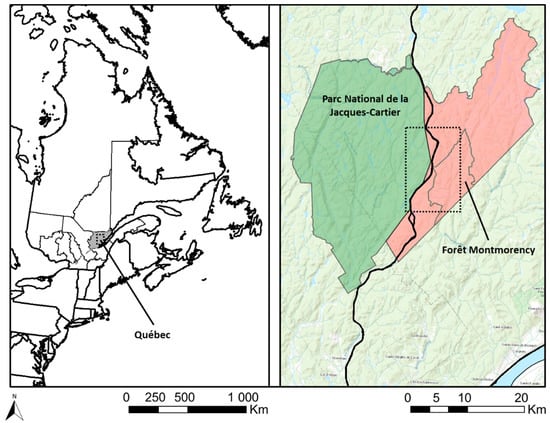
Figure 1.
Map showing the study area in Quebec, Canada.
2.2. Stand Selection and Defoliation Estimation
An aerial survey was conducted over 20,000 ha in the Réserve faunique des Laurentides in August 2012 and 2013 by the Ministère des Forêts, de la Faune et des Parcs du Québec (hereinafter MFFP) to assess the hemlock looper defoliation. An aircraft flew at 160 km/h and a 240 m altitude along flight lines spaced by 4.5 km [21]. A spatially explicit mapping tool developed by the MFFP was used for digitizing defoliated patches with a stylus on a touchscreen computer. To help draw the patches, a topographic layer was added to the software as a background on the screen and was directly linked to the aircraft’s route. The delineated patches were automatically digitized and georeferenced with ArcGIS. Defoliated patches were classified according to three severity classes: light (1%−34%), moderate (35%−69%), and heavy (70%−100%). The MFFP defines light defoliation as a loss of foliage in the upper third of the crown of some trees in a stand. Moderate defoliation is a loss of foliage in the upper third of the crown of most trees and on the full crown length of several trees, and heavy defoliation is a loss of foliage along the full crown length of most trees [21]. The MFFP defoliation classes obtained by the aerial survey thus combine coarse estimates at the tree and stand scales.
During the spring of 2013, 36 circular plots (400 m2) were established in mature balsam fir stands split equally among four defoliation classes (none, light, moderate, and heavy) using the 2012 MFFP defoliation maps (Figure 2). Plots were spaced by at least 50 m, and their center was georeferenced. Four codominant balsam firs were randomly selected in each plot to assess defoliation. On those trees, defoliation was assessed from the ground level during the spring following defoliation (before bud break) by two observers using binoculars after both the first (2012) and second (2013) year of the outbreak. The method used in this study was inspired by Fettes [22], who developed a visual chart for assessing shoot defoliation by the spruce budworm. This usually involves laboratory assessments on shoots of field-collected branches. To avoid disturbing and stressing the experimental trees under study, we used binoculars to apply the Fettes method directly in the field without collecting branches. The two observers randomly selected three branches in the upper third of the crown of each tree and visually assessed defoliation on the basis of the 10% defoliation classes on the shoots from the past 5 years (shoots numbered backward as n to n-4, corresponding to 2012 down to 2008 foliage for estimating defoliation in the first year of the outbreak). All defoliation values for shoots from each of the three selected branches on a tree were averaged for each observer, and estimates were averaged for both observers in order to provide the mean tree defoliation. Then, by averaging the defoliation of all four sampled trees in a plot, we obtained the mean plot defoliation. Furthermore, only the defoliation on the current-year shoots was used as a proxy for the overall defoliation.
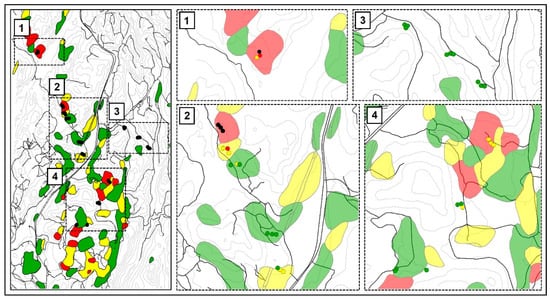
Figure 2.
Aerial survey maps showing hemlock looper defoliation patches in the Reserve faunique des Laurentides in Quebec, Canada, in 2012. Three severity levels are shown: light (green), moderate (yellow), and heavy (red). The black dots on the left map show the study plot locations. The colored dots on maps 1–4 show corresponding ground-level defoliation estimates (light, moderate and heavy being the green, yellow, and red dots, respectively, and the black dots express the dominance of dead trees).
2.3. Statistical Analysis
To determine if defoliation of the current-year shoots (n) could be used as a proxy for the overall defoliation, we carried out linear and non-linear regressions between those estimates and estimates on each of the n-1 to n-4 shoots for the first and second year of the outbreak separately. The lm function from the stats package of R [23] was used for linear regressions. When linear models did not provide a good fit, mostly because of a strong effect of the 100% maximum defoliation (asymptote), we carried out non-linear regressions. We used the nls function from the stats package [23] to fit asymptotic regressions with weighted least-squares estimations of the parameters. We first ran the models with approximate starting coefficient values (e.g., 100% defoliation for the asymptote coefficient) and the function and then built the best model based on the dataset. In order to evaluate the accuracy of the MFFP aerial survey, we compared the ground defoliation estimates between their corresponding aerial survey defoliation classes using ANOVAs, followed by Sidak’s all pairwise comparisons (post-hoc analysis) for the first and second years of the outbreak separately. ANOVA and the emmeans function (using estimated marginal means) from the emmeans package of R [24] were used for the pairwise comparisons.
3. Results
The relationships between defoliation on the current-year shoots and previous-year shoots were significant, but the strength of these relationships (Pearson’s product–moment correlation coefficient (r)) decreased slightly but progressively with shoot age, from n-1 to n-4 shoots in both years (Figure 3 and Figure 4). These relationships were positive and linear in the first year of the outbreak (Figure 3) but clearly non-linear in the second year (Figure 4). Thus, we then used Spearman’s rank correlation rho (ρ) to estimate the correlation of monotonic functions. The current-year shoots which defoliated at moderate to heavy levels were always observed on trees on which previous-year foliage was heavily or completely defoliated, while light defoliation occurred on trees affected by all levels of defoliation. However, lightly defoliated previous-year shoots were always correlated with very lightly defoliated current-year shoots (Figure 4).
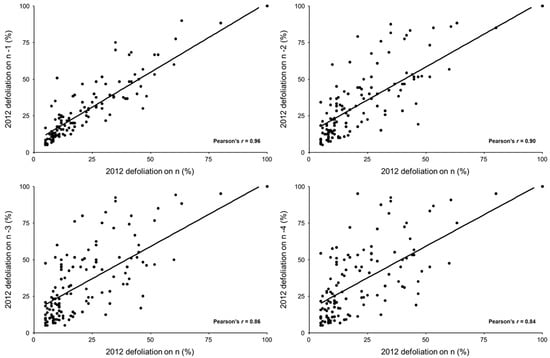
Figure 3.
Relationships between defoliation on the current-year vs. previous-year shoots (n-1 to n-4) for the first year (2012) of the hemlock looper outbreak, as assessed using the field Fettes method.
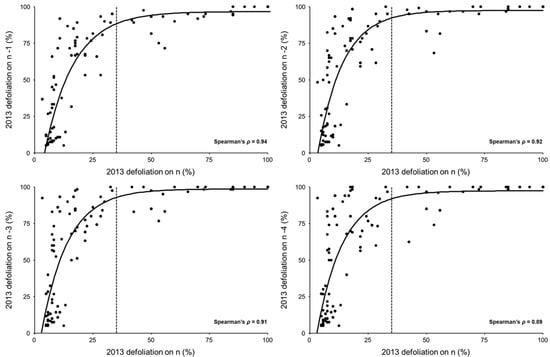
Figure 4.
Relationships between defoliation on the current-year vs. previous-year shoots (n-1 to n-4) for the second year (2013) of the hemlock looper outbreak, as assessed using the field Fettes method. The vertical dotted line indicates the limit between the light and moderate to heavy defoliation.
The ANOVAs comparing ground-level defoliation estimates of the different aerial survey classes were significant for both the first year (overall defoliation: F = 30.98; df = 3; p < 0.0001, current-year shoot defoliation: F = 32.60; df = 3; p < 0.0001) and the second year of the outbreak (overall defoliation: F = 19.09; df = 2; p < 0.0001, current-year defoliation: F = 19.01; df = 2; p < 0.0001). Such results were expected, but significant ANOVAs were required to justify the post-hoc analysis. For the first year of the outbreak, Sidak’s pairwise comparisons showed that defoliation was significantly different for all pairs of classes except between the no defoliation and light defoliation classes (Figure 5). All plots of the no-defoliation class were misclassified since light to moderate defoliation was observed in all of them using ground-level estimates. Nevertheless, plots in the light, moderate, and heavy defoliation classes were generally well assessed for the first year of the outbreak, with a slight overestimation for the heavy defoliation class, half of the plots being moderately defoliated, while the other half were completely defoliated (Figure 5 and Figure 6). In the second year of the outbreak, almost only the heavy defoliation class was correctly assessed according to the ground-level estimates of the overall and current-year shoots defoliation (Figure 5 and Figure 6). Nonetheless, four of the heavily defoliated plots were, in fact, misclassified as no annual and subsequent defoliation could have been observed because all trees died (100% defoliation) in the early fall of the first year of the outbreak (2012). The fit was slightly better with the defoliation on the current-year shoots in the moderate and heavy defoliation classes. No plot remained in the light defoliation class of the aerial survey after the second year of the outbreak, but 21 plots were misclassified as non-defoliated even if the ground-level estimates varied from light to complete defoliation.
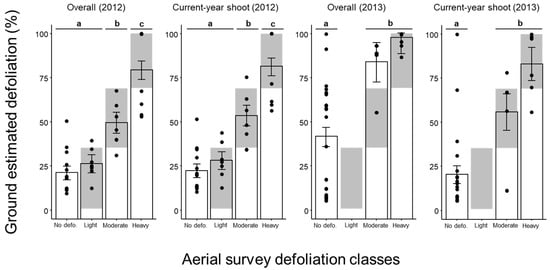
Figure 5.
Validation of the aerial survey defoliation classes using the overall or current-year shoot defoliation estimated with the field Fettes method after the first (2012) and second (2013) year of the hemlock looper outbreak. Different letters highlight significant differences in the defoliation estimated between the ground and the aerial defoliation classes after Tukey’s pairwise comparisons. Dots represent the plot mean defoliation, and error bars represent the standard error of the mean for a given class. Gray areas represent the interval of percentage defoliation included in each MFFP class.
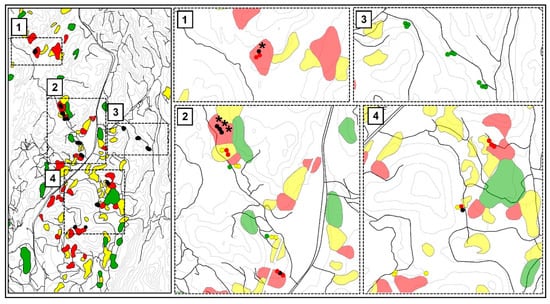
Figure 6.
Aerial survey maps showing the hemlock looper defoliation patches in the Reserve faunique des Laurentides in Quebec, Canada, in 2013. Three severity levels are shown: light (green), moderate (yellow), and heavy (red). The black dots on the left map show the study plot locations. The colored dots on maps 1–4 show corresponding ground-level defoliation estimates (light, moderate and heavy being green, yellow, and red dots, respectively, and the black dots express the dominance of dead trees). Black stars on maps 1 and 2 express the stands in which dead trees were dominating after the 1st year of the outbreak (2012).
4. Discussion
Our results show that the current-year shoot defoliation provides accurate estimates of the overall defoliation in the first year of the outbreak, as it is strongly related to the previous year’s shoot defoliation, with the strength of the relationship gradually decreasing for the one-year-old to four-year-old foliage. Thus, the strength of the relationship is highest with the foliage that provides the greatest contribution to photosynthesis after the current-year foliage [25]. The relationship was still strong during the second year of the outbreak, but it was no longer linear. Nevertheless, it could be useful for management purposes as it could be used to predict tree survival. Indeed, 98% of trees survived and recovered if the second-year defoliation on the current-year shoots was light (less than 35% of defoliation), regardless of the defoliation level in the first year of the outbreak (trees on the left-hand side of the dashed lines in Figure 3). However, the second year of moderate to heavy defoliation on the current year’s shoots resulted in the death of most trees (80%) that were heavily defoliated during the first year of the outbreak (unpublished data) (trees on the right-hand side of the dashed lines in Figure 3).
Our results also show that the aerial defoliation survey carried out in Quebec was reliable for delineating stands with light and moderate defoliation during the first year of a hemlock looper outbreak. Ground-level defoliation estimates fell within the limits of the light and moderate classes obtained with the aerial survey for 78% of the plots; however, the fit was lower for the heavy defoliation class, with 50% of the plots being well classified. The light defoliation class of the aerial survey was composed of plots that tended to be in the upper portion of this class, suggesting that very light defoliation might be difficult to detect with an aerial survey. This was confirmed by the light defoliation observed with ground-level estimates in nearly all plots located in non-defoliated areas mapped with the aerial survey. In fact, these plots were only slightly less defoliated than those located in the light defoliation class, while they should have ranged between 0 and 1% defoliation. MacLean and MacKinnon [16] also reported, for the spruce budworm, that most errors in aerial survey defoliation estimates come from the difficulties of correctly assessing light defoliation (11%–30% in their study).
Aerial surveys of defoliation from the hemlock looper on balsam fir in Quebec were more accurate than those previously made in Newfoundland in the first year of an outbreak [10]. For instance, in Newfoundland, balsam firs of the moderate and heavy defoliation classes were only lightly or moderately defoliated (25.8% and 43.4%, respectively) [10]. However, in the second year of the outbreak in our study, the aerial survey underestimated defoliation, except for the heavy defoliation class, which was accurate according to the ground-level estimates of the overall defoliation. Nevertheless, stands that were completely (100%) defoliated in 2012 were still classified in the heavy defoliation class in 2013 rather than in a “Mortality” class. This “Mortality” class was added in the 2014 aerial survey [26] but stand mortality should have been acknowledged as soon as 2013. This problem was also observed by the senior author (C. Hébert) during a previous outbreak on the Mingan Islands in northeastern Quebec. In Newfoundland, Iqbal and MacLean [10] still reported an overestimation of defoliation by the aerial survey during the second year of an outbreak. However, defoliation in Newfoundland was much lower than in Quebec, with an average of 54.6% after 2 years and 36.7% on the current-year foliage. In our study, defoliation on the current-year shoots provided a better fit with the moderate and heavy defoliation classes of the aerial survey during the second year of the outbreak than the overall defoliation, suggesting that aerial surveys no longer provide an accurate assessment of the hemlock looper defoliation.
Defoliation estimates obtained from aerial surveys are strongly influenced by tree foliage reddening. After the first year of a severe outbreak, a large proportion of needles have already fallen off the branches on trees that are moderately or heavily defoliated; therefore, the reddening of the current-year shoots is often the only cue perceived by observers in aerial surveys. Thus, the severity of defoliation during the first year of an outbreak may influence the accuracy of the defoliation assessment during the second year of an outbreak. The aerial defoliation survey is much less reliable during the second year of an outbreak of the hemlock looper as the green background coloration of the trees in the first year of an outbreak is replaced by a characteristic gray coloration when trees lose their needles, which also varies with the severity of defoliation, the shape/size of tree crowns, and the tree density. The severity of the annual defoliation might be the same or even higher than during the first year of an outbreak, but the presence of smaller and discontinuous red patches due to the lower amount of needles left to redden may lead to an underestimation of defoliation. Ground-level defoliation estimates on the current-year shoots can help to appraise the risk of tree mortality in the following year. Without measures to control the hemlock looper populations, stands affected by moderate or heavy defoliation are at risk of extensive tree mortality in the following year if the density remains high. Thus, developing models for predicting defoliation on the current-year shoots using egg densities would be useful for assisting forest pest managers in control decision making.
5. Conclusions
We showed that the current-year shoot defoliation by the hemlock looper provides accurate estimates of the overall defoliation in the first year of the outbreak. This relationship was still strong during the second year of the outbreak, but it was no longer linear. Nevertheless, it could be useful to predict tree survival. Our results also showed that light and moderate defoliation patches delimited by the aerial defoliation survey were accurate during the first year of the outbreak, but light defoliation often remained undetected. In the second year of the outbreak, the aerial survey underestimated defoliation, except for the heavy defoliation class. However, stands that were completely (100%) defoliated in the first year of the outbreak were still classified in the heavy defoliation class in the second year of the outbreak rather than in a “Mortality” class. Cumulative defoliation on all age classes of foliage brings a new challenge to crews assigned to aerial survey programs.
Author Contributions
Conceptualization, all authors; methodology, J.-M.B., R.B. and C.H.; formal analysis, J.-M.B.; writing—original draft preparation, J.-M.B. and C.H.; writing—review and editing, all authors; supervision, É.B., C.C., R.B. and C.H.; project administration, C.H. and R.B.; funding acquisition, C.H. and É.B. All authors have read and agreed to the published version of the manuscript.
Funding
Funding was provided by an NSERC discovery grant (RGPIN 436015-2013) to Christian Hébert and by the iFor Research Consortium through contributions from the Natural Science and Engineering Research Council of Canada (NSERC, CRDPJ 355226-2007), the MFFP, the Conseil de l’industrie forestière du Québec (CIFQ), CFS-NRCan, and the Société de protection des forêts contre les insectes et maladies (SOPFIM).
Institutional Review Board Statement
Not applicable.
Informed Consent Statement
Not applicable.
Data Availability Statement
Aerial defoliation shapefiles used in this study are available in the public domain at: https://www.donneesquebec.ca/recherche/dataset/donnees-sur-les-perturbations-naturelles-insecte-arpenteuse-de-la-pruche/resource/ae2f8f09-c955-417e-947c-78ea7a23858f (accessed on 26 May 2022).
Acknowledgments
We thank Anne Cotton-Gagnon from Université Laval (iFor Research Consortium) and Yves Dubuc from the Canadian Forest Service of Natural Resources Canada (CFS-NRCan) for the field and laboratory technical support. We are grateful to Olivier Jeffrey and Jonathan Boucher from the iFor Research Consortium for their assistance with the experimental design, site selection, and statistical analysis. We also thank David MacLean from the University of New Brunswick for his advice on estimating defoliation and Mathieu Bouchard from MFFP for reviewing a preliminary version of the manuscript. Sincere thanks to Charles Villeneuve and Julie Boulianne, from Université Laval, for providing access to the Forêt Montmorency, and Benoit Dubeau, from the Société des établissements de plein air du Québec (SÉPAQ) for providing access to the Parc national de la Jacques-Cartier. Finally, special thanks to the MFFP for providing the shapefiles of aerial defoliation.
Conflicts of Interest
The authors declare no conflict of interest. The funders had no role in the design of the study; the collection, analyses, or interpretation of data; the writing of the manuscript; or in the decision to publish the results.
References
- Hébert, C.; Brodeur, J. Lambdina fiscellaria (Guenée), hemlock looper (Lepidoptera: Geometridae). In Biological Control Programmes in Canada 2001–2012; Mason, P.G., Gillespie, D., Eds.; CABI Publishing: Wallingford, UK, 2013; pp. 203–207. [Google Scholar]
- Trial, H.; Trial, J.G. A Method to Predict Defoliation of Eastern Hemlock (Tsuga canadensis [L.] Carr.) by Eastern Hemlock Looper (Lambdina fiscellaria fiscellaria [Gn.]) Using Egg Sampling; Technol. Rep. No., 31; Maine Dep., Conserv.; Maine For., Serv.; Insect Disease Manag., Div.; Me. Forest Service [ie Bureau of Forestry]: Sainte-Foy, QC, Canada, 1992.
- Jobin, L. L’arpenteuse de la pruche, insecte insulaire? Environ. Can. Cent. Rech. For. Laurent. St. -Foy Qc. Milieu 1973, 7, 8–12. [Google Scholar]
- Jobin, L. L’arpenteuse de la pruche: Un insecte insulaire. Racine 1980, 2, 5–7. [Google Scholar]
- Hébert, C.; Jobin, L.J. The hemlock looper. Laur. For. Cent. Can. For. Serv. Nat. Resour. Can. St. -Foy QC. Inf. Leafl. 2001, LFC-4, 17. [Google Scholar]
- Arsenault, J.-E.; Hébert, C.; Tousignant, A.; Berthiaume, R.; Bauce, É. L’arpenteuse de la pruche: Une arrivée remarquée. Bull. Conserv. 2014, pp. 5–9. Available online: https://docplayer.fr/38015072-L-arpenteuse-de-la-pruche-une-arrivee-remarquee.html (accessed on 13 July 2022).
- De Gryse, J.J.; Schedl, K. An account of the eastern hemlock looper, Ellopia fiscellaria Gn., on hemlock, with notes on allied species. Sci. Agric. 1934, 14, 523–539. [Google Scholar]
- Watson, E.B. An account of the eastern hemlock looper, Ellopia fiscellaria Gn., on balsam fir. Sci. Agric. 1934, 14, 669–678. [Google Scholar]
- Carroll, W.J. History of the hemlock looper, Lambdina fiscellaria fiscellaria (Guen.), (Lepidoptera: Geometridae) in Newfoundland, and notes on its biology. Can. Entomol. 1956, 88, 587–599. [Google Scholar] [CrossRef]
- Iqbal, J.; MacLean, D.A. Estimating cumulative defoliation of balsam fir from hemlock looper and balsam fir sawfly using aerial defoliation survey in western Newfoundland, Canada. For. Ecol. Manage. 2010, 259, 591–597. [Google Scholar] [CrossRef]
- Dobesberger, E.J. A sequential decision plan for the management of the eastern hemlock looper, Lambdina fiscellaria fiscellaria (Lepidoptera: Geometridae), in Newfoundland. Can. J. For. Res. 1989, 19, 911–916. [Google Scholar] [CrossRef]
- Blais, J.R. The vulnerability of balsam fir to spruce budworm attack in northwestern Ontario, with special reference to the physiological age of the tree. For. Chron. 1958, 34, 405–422. [Google Scholar] [CrossRef]
- MacLean, D.A. Vulnerability of fir-spruce stands during uncontrolled spruce budworm outbreaks: A review and discussion. For. Chron. 1980, 56, 213–221. [Google Scholar] [CrossRef]
- Hébert, C.; Jobin, L.; Berthiaume, R.; Coulombe, C.; Dupont, A. Changes in hemlock looper (Lepidoptera: Geometridae) pupal distribution through a 3-year outbreak cycle. Phytoprotection 2001, 82, 57–63. [Google Scholar] [CrossRef][Green Version]
- Hébert, C.; Jobin, L.; Berthiaume, R.; Mouton, J.-F.; Dupont, A.; Bordeleau, C. A new standard pupation shelter for sampling pupae and estimating mortality of the hemlock looper (Lepidoptera: Geometridae). Can. Entomol. 2004, 136, 879–887. [Google Scholar] [CrossRef]
- MacLean, D.A.; MacKinnon, W.E. Accuracy of aerial sketch-mapping estimates of spruce budworm defoliation in New Brunswick. Can. J. For. Res. 1996, 26, 2099–2108. [Google Scholar] [CrossRef]
- MacLean, D.A.; Lidstone, R.G. Defoliation by spruce budworm: Estimation by ocular and shoot-count methods and variability among branches, trees, and stands. Can. J. For. Res. 1982, 12, 582–594. [Google Scholar] [CrossRef]
- Gray, D.R.; Régnière, J.; Boulet, B. Analysis and use of historical patterns of spruce budworm defoliation to forecast outbreak patterns in Quebec. For. Ecol. Manag. 2000, 127, 217–231. [Google Scholar] [CrossRef]
- Candau, J.N.; Fleming, R.A. Landscape-scale spatial distribution of spruce budworm defoliation in relation to bioclimatic conditions. Can. J. For. Res. 2005, 35, 2218–2232. [Google Scholar] [CrossRef]
- Saucier, J.-P.; Robitaille, A.; Bergeron, J.-F.; Gosselin, J. Les Régions Écologiques du Québec Méridional, 4th ed.; Carte à l’échelle de 1/1 250 000; Direction des inventaires forestiers, Ministère des Ressources naturelles et de la Faune: Québec, QC, Canada, 2011. [Google Scholar]
- Ministère des Ressources naturelles et de la Faune. Aires infestées par l’arpenteuse de la pruche au Québec en 2012; Direction de la Protection des Forêts, Ministère des Ressources Naturelles et de la Faune: Québec, QC, Canada, 2012. [Google Scholar]
- Fettes, J.J. Investigations of Sampling Techniques for Population Studies of the Spruce Budworm on Balsam Fir in Ontario; Forest Insect Laboratory: Sault Ste. Marie, ON, Canada, Annual Technical Report; 1950. [Google Scholar]
- R Core Team. R: A Language and Environment for Statistical Computing; R Foundation for Statistical Computing: Vienna, Austria, 2021. Available online: https://www.R-project.org/ (accessed on 13 July 2022).
- Lenth, R. Emmeans: Estimated Marginal Means, aka Least-Squares Means. 2021. R package version 1.7.0. Available online: https://CRAN.R-project.org/package=emmeans (accessed on 13 July 2022).
- Clark, J. Photosynthesis and respiration in white spruce and balsam fir. State Univ. Coll. For. Technol. Publ. 1961, 85, 1–72. [Google Scholar]
- Ministère des Forêts, de la Faune et des Parcs. Aires Infestées par L’arpenteuse de la Pruche au Québec en 2014. Direction de la Protection des Forêts. Service de la Gestion des Ravageurs Forestiers; Ministère des Ressources naturelles et de la Faune: Québec, QC, Canada, 2014.
Publisher’s Note: MDPI stays neutral with regard to jurisdictional claims in published maps and institutional affiliations. |
© 2022 by the authors. Licensee MDPI, Basel, Switzerland. This article is an open access article distributed under the terms and conditions of the Creative Commons Attribution (CC BY) license (https://creativecommons.org/licenses/by/4.0/).